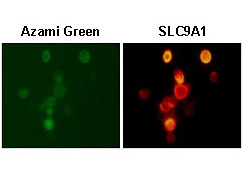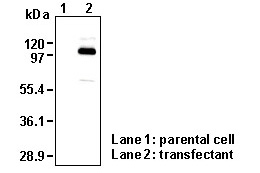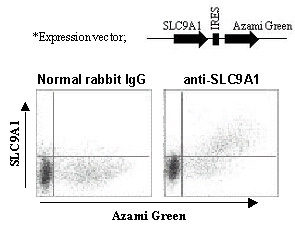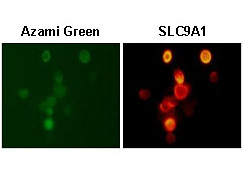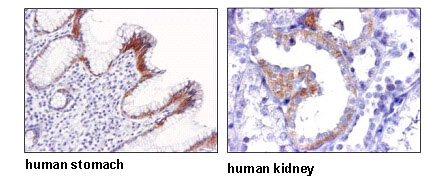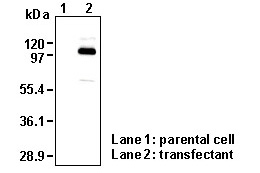Anti-SLC9A1 (NHE1) (Human) pAb
| Code | Size | Price |
|---|
| MBL-BMP023 | 100 ul | £340.00 |
Quantity:
Prices exclude any Taxes / VAT
Overview
Host Type: Rabbit
Antibody Isotype: IgG
Antibody Clonality: Polyclonal
Regulatory Status: RUO
Target Species: Human
Applications:
- Flow Cytometry
- Immunocytochemistry (ICC)
- Immunohistochemistry (IHC)
- Western Blot (WB)
Shipping:
4°C
Storage:
-20°C
Images
Documents
Further Information
Applications:
WB - 1:1000 (chemiluminescence detection system) FCM - 1:100 ICC - 1:100 IHC - 1:500 (Heat treatment required for paraffin)
Background:
SLC9A1 (NHE1), a member of the Na+/H+ exchanger family, is a ubiquitous membrane protein that regulates intracellular pH and cell volume. Furthermore, SLC9A1 is known to interact with the actin cytoskeleton. Fibroblasts expressing mutated NHE1 that fails to interact with actin-related proteins show impaired organization of focal adhesion points and actin stress fibers, and an irregular cell shape. Polymorphisms of the SLC9A1 gene have been reported in association with essential hypertension.
Formulation:
50 ul volume of PBS containing50% glycerol, pH 7.2. No preservative is contained.
Gene IDs:
Human: 6548 Mouse: 20544
Immunogen Translated:
Synthetic peptide derived from human SLC9A1
Reactivity:
This antibody can be used to stain endogenous antigen in paraffin embedded human tissues including stomach and kidney by immunohistochemistry. The reactivity of this antibody has been confirmed by Western blotting, Immunocytochemistry and Flow cytometry to detect the full-length of human SLC9A1 transiently expressed in HEK 293T cells
Shelf Life:
1 year
Source:
This antibody was affinity purified from rabbit serum. The rabbit was immunized with a synthetic peptide derived from human SLC9A1.
Target:
SLC9A1
References
1) Denker, S. P., et al., Mol Cell 6, 1425-1436 (2000)
2) Dudley, C. R., et al., Hum Genet 86, 79-83 (1990)
3) Sardet, C., et al., Cell 56, 271-280 (1989).



